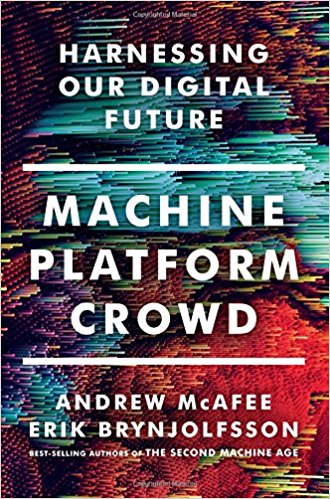 When I read that Andrew McAfee and Erik Brynjolfsson, co-authors of The Second Machine Age, were releasing another book, I ordered it. While the topic of how technology will change our lives is no longer as fresh a concept as it was when they released The Second Machine Age in January 2014, their latest tome focuses more on the economic impact of technology today and in the future.
When I read that Andrew McAfee and Erik Brynjolfsson, co-authors of The Second Machine Age, were releasing another book, I ordered it. While the topic of how technology will change our lives is no longer as fresh a concept as it was when they released The Second Machine Age in January 2014, their latest tome focuses more on the economic impact of technology today and in the future.
The authors profile tech accomplishments that allow computers to beat the world’s reigning Go champion, enable companies to build huge revenues without assets (Uber, Facebook, Airbnb, etc.), and use an online crowd to write, design, and build. These include the Machine, Platform, and Crowd examples referenced in the title, the counterparts for each of which are the human mind, products, and the core (knowledge, processes, expertise, and capabilities companies have built).
In order to succeed in today’s tech environment, McAfee and Brynjolfsson maintain that “companies need to rethink the balance between minds and machines, between products and platforms, and between the core and the crowd.” They posit that phase one of the Second Machine Age occurred in the mid-1990s. Phase two, represented by events prophesied in science fiction coming true, may have started in 2010 and represents the period when machines learn how to solve problems on their own (e.g., driverless cars and IBM’s Watson beating Jeopardy champs). In addition, for the first time in history, most adults are digitally connected.
The authors organized their new book into three parts. The first, Mind and Machine, provides examples of the increasing ability of automation to make better decisions (removing human bias) in many different areas, such as analyzing individuals’ creditworthiness. However, they note that tomorrow’s companies will not automate all decisions. Instead, humans are able to absorb lots of different data through senses and have developed common sense that has not yet been replicated or constructed through a computer algorithm.
People who can utilize data to assist their decision making are more likely to thrive as automation and data collection continues to expand. Artificial intelligence (AI) continues to develop and is responsible for many new accomplishments. Current AI systems are developed through “supervised learning” (people structure the system to ingest specific data sets). When algorithms are developed for “unsupervised learning” (how we learn), experts believe we’ll be closer to developing AGI (artificial general intelligence) where the software is capable of solving many different problems.
McAfee and Brynjolfsson suggest that the best solutions will occur when mind and machines collaborate. Jobs that will be least impacted by technology will be those that tap into our social drives (compassion, pride, embarrassment, envy, justice, and solidarity). The authors are confident that the “ability to work effectively with people’s emotional states and social drives will remain a deeply human skill for some time to come.” People will be critically important, just not always in the same roles they occupy today.
The successful platform businesses described in Part 2, Product and Platform, are no surprise to astute students of business or to readers of books like The Platform Revolution. McAfee and Brynjolfsson provide their perspective as economists and define a platform as a “digital environment with near-zero marginal cost of access, duplication, and distribution.” For most of history, few goods and services have been free, perfect, and instant. The authors note that with digital, networked goods, these free properties are automatic.
Platforms capitalize on the economics of free, perfect, and instant. Some goods become more valuable to users as more people use them (e.g., WhatsApp, an example of a network effect). Platform economics continue to take industries and their incumbents by surprise. Platforms like iTunes and Spotify changed the nature of selling packaged music. Perfect digital copies of songs are much cheaper as an unbundled product. In fact, for the first half of 2016, streaming accounted for 47% of total U.S. music revenues. The economics of free, perfect, and instant is a trend that shows no sign of fading, according to McAfee and Brynjolfsson.
Platforms embrace two key microeconomic concepts – demand rises as cost decreases and the notion of complements. Apps were the complementary product that drove demand for iPhones. After Steve Jobs’ decision to open up the app platform to outside developers, iPhone sales skyrocketed. In addition, not all apps are free and Apple collects 30% of sales from externally developed apps. It also collects data about behaviors and preferences of platform members. Platform owners like Apple decide who is allowed to access their platform and to provide apps. That curation is valuable in that it allows the owners to control the development of the platform without allowing others to potentially lure members away.
The huge amount of data generated by platforms makes them attractive candidates for adopting AI. The authors believe that in many sectors, platform nonparticipants will see their margins shrink as well as their market share. Companies that understand the economics of two-sided networks have prospered and smart platform owners manage the two sides excellently.
With the advent of widespread access to the Internet and knowledge content, core repositories of knowledge like libraries have been upstaged by new participants that McAfee and Brynjolfsson call the “crowd.” The differences between the Web and the world’s libraries illustrate how different the crowd is from the core. Libraries house millions of books, while the Web houses millions of books but also music, pictures, podcasts, videos, virtual reality environments, etc. No one is in charge of all of the Web content, whereas the core is determine by governments and groups with the power to say no.











